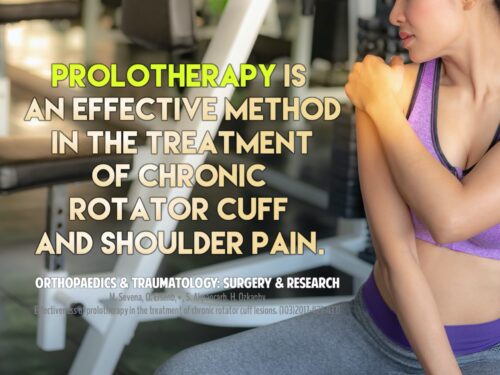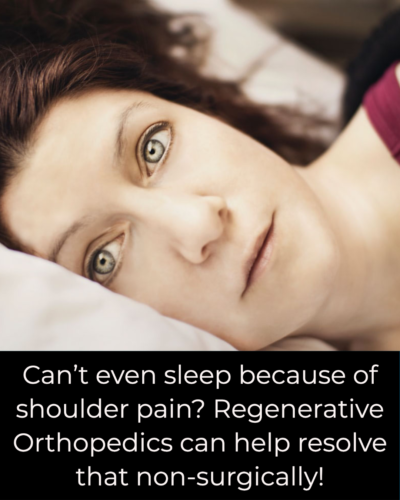
Prolotherapy is effective for chronic rotator cuff pain
Rotator cuff injuries are prevalent. Most of us have heard about rotator cuff tears and even impingement syndromes. We have probably seen and heard about them in the news. We often hear about professional athletes taken out of the game and possibly facing surgery. But these injuries affect the general public too!
Rotator cuff injuries are so common that they affect about a quarter of the population over 50 years of age.1 Many people are opting for surgery to fix their injury. The numbers of surgical repairs are going up and up! In some locations, surgeries are doubling in number, and particular surgeries, like arthroscopic rotator cuff repairs, have increased by 353%. 2,3 But are all of these surgeries really necessary? Especially considering the economic costs, the time needed for rehabilitation, and other personal risks!
In so many rotator cuff injury cases, Regenerative Orthopedic techniques, like Stem Cell Therapy, PRP, and Prolotherapy, can be used to repair the shoulder. Plus, these treatments effectively repair the injury without the need for surgery. Regenerative Orthopedics has many advantages over surgery. First and foremost, it gets to the root cause of the problem. What do we mean by that? Rotator cuff injuries affect the tendon and ligaments of the shoulder. And treatments like Prolotherapy are especially effective at healing soft tissue like tendons and ligaments.
Besides, Regenerative Orthopedic options require much less rehabilitation time. They also help you avoid the risks associated with rotator cuff surgery, such as frozen shoulder, deep infection, and dislocation. And many patients who develop these complications also end up needing a second surgical procedure.

Rotator Cuff Injuries Affect Your Sleep Too!
As mentioned previously, many people are at risk for rotator cuff injuries. Among athletes, these injuries are more common with pitchers, tennis players, swimmers, and any sport that involves a throwing motion or repeated over-the-head movements. Non-athletes who repeatedly use overhead movements are also at increased risk for rotator cuff injuries. For example, rotator cuff tendinitis occurs when the rotator cuff’s small muscles become strained, causing weakness of these structures and subsequent tendonitis. Left untreated, a chronic condition of tendinosis can develop.
Another shoulder condition involving the rotator cuff is impingement syndrome. This condition occurs when the rotator cuff tendon becomes pinched between the head of the humerus and the acromion process during the arm’s motion raised above the head. This happens because the space gets narrowed, as occurs when the rotator cuff muscles weaken, and the humeral head rides high in the socket.
Impingement can also ensue when bone spurs and calcium deposits narrow the space. Impingement also occurs when the contents of the subacromial space increase in size. This is most often due to a swollen rotator cuff tendon or bursa, which is painfully squeezed between the humeral head and the acromion process.
Treatment for rotator cuff injuries usually includes rest, non-steroidal anti-inflammatory drugs (NSAIDs), physical therapy, and cortisone injections. Cortisone has a substantial anti-inflammatory property, reducing the tendon and bursa’s swelling and relieving the symptoms. Unfortunately, cortisone has also been found to lead to degeneration of the soft tissue eventually. It’s so much better to regenerate the joint. And you can get regenerative results with Regenerative Orthopedics.
Many common treatments only provide temporary help. That’s because the underlying cause is not addressed, and the problem usually returns. Degenerative fraying and tearing of the tendon may occur when the tendon is allowed to be in a constant state of irritation over time. Non-Surgical Regenerative Orthopedics is a great way to address the underlying tendon and ligament injuries and repair all of the involved soft tissue. The result is a re-strengthening of the rotator cuff, an improved shoulder joint, and an excellent chance for a full recovery and performance.
1Blitzer Charles, M. “Arthroscopy: The Journal of Arthroscopic & Related Surgery.” The Journal of Arthroscopic and Related Surgery 9.4 (1993): 414-416.
2Iyengar, Jaicharan J., et al. “Current trends in rotator cuff repair: surgical technique, setting, and cost.” Arthroscopy: The Journal of Arthroscopic & Related Surgery 30.3 (2014): 284-288.
3Traven, Sophia A., et al. “The 5-factor modified frailty index predicts complications, hospital admission, and mortality following arthroscopic rotator cuff repair.” Arthroscopy: The Journal of Arthroscopic & Related Surgery 36.2 (2020): 383-388.
Want more information about treating Rotator Cuff injuries? Click here to read our article called, “Stop Shoulder Pain from Rotator Cuff and Other Shoulder Injuries.”